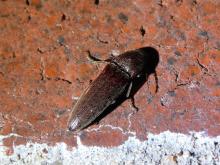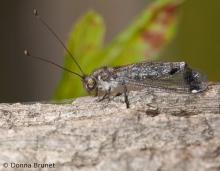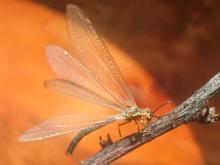Land Invertebrates
Media

Species Types
Scientific Name
More than 400 species in North America north of Mexico
Description
The name is a warning: blister beetles are famous for their chemical defenses. Beetles in this family can exude an oil that can cause a person’s skin to blister.
Media

Species Types
Scientific Name
Approximately 1,000 species in North America
Description
Their streamlined shape is distinctive, but the behavior of click beetles is even more unique: Placed on their backs, these beetles flip suddenly into the air with an audible click.
Media

Species Types
Scientific Name
Tabanus, Chrysops, and related genera
Description
Meet the horse fly: Stealthily, one will land on your back, slice your skin, and lap your blood. By the time it starts to hurt and you swat at it, the painful, itchy welt is rising.
Media

Species Types
Scientific Name
8 species in North America north of Mexico
Description
An owlfly looks like a dragonfly with a butterfly’s head. Dragonfly shaped and sized, they have long, clubbed antennae and large, bulging eyes. Look for them in summertime dusks and evenings.
Media

Species Types
Scientific Name
More than 100 species in North America north of Mexico
Description
Adult antlions look something like drab damselflies. These insects are most familiar in their immature stages, called doodlebugs, which create pits in sand for trapping ants.
Media

Species Types
Scientific Name
Pachypsylla spp.
Description
Hackberry psyllids are a genus of tiny, planthopper-like bugs. As larvae, they develop within the leaves, twigs, buds, or bark of hackberry trees. The trees form warty galls in response to their presence. In the fall, tiny adult hackberry psyllids cling to window screens.
Media

Species Types
Scientific Name
Entypus aratus, E. unifasciatus, E. fulvicornis, and others
Description
Spider wasps in genus Entypus are bluish black and usually have some amount of amber color on their dark, smoky wings. Some species have bright yellow antennae.
Media

Species Types
Scientific Name
Rabidosa punctulata
Description
The dotted wolf spider has a solid brown stripe running down the middle of the abdomen, seen from above. Like other wolf spiders, females have strong maternal instincts, carrying their spiderlings around on their back until they can be on their own.
Media

Species Types
Scientific Name
About 1,000 species in North America north of Mexico
Description
Many apid bees are well-known. This family includes the familiar honeybee, bumblebees, and carpenter bees, plus many that are less well-known. With few exceptions, most of Missouri's apid bees are native, solitary species.
Media

Species Types
Scientific Name
About 28 species in North America
Description
Horntails look a lot like wasps but have a taillike spine that projects from the tip of the abdomen. Their cylindrical bodies also lack the narrow waist so common in wasps.
See Also



Media

Species Types
Scientific Name
Cisseps fulvicollis
Description
The yellow-collared scape moth is more often “orange-collared.” And whether you think it looks more like a firefly or a wasp, it’s still a moth!
Media

Species Types
Scientific Name
Nearly 150 species in North America north of Mexico
Description
Slim, delicate plume moths are instantly recognizable by their T-shaped silhouette, long legs, and muted shades of tan and brown. It can be hard to separate the various species.
Media

Species Types
Scientific Name
Pyrrharctia isabella
Description
Not many people know the adult Isabella tiger moth when they see one, but we’re all acquainted with its caterpillar, the woolly worm, or woolly bear.
About Land Invertebrates in Missouri
Invertebrates are animals without backbones, including earthworms, slugs, snails, and arthropods. Arthropods—invertebrates with “jointed legs” — are a group of invertebrates that includes crayfish, shrimp, millipedes, centipedes, mites, spiders, and insects. There may be as many as 10 million species of insects alive on earth today, and they probably constitute more than 90 percent all animal species.





















